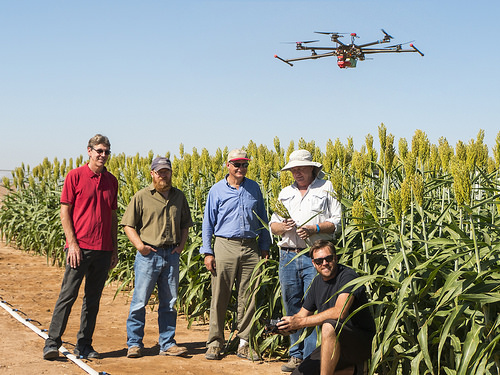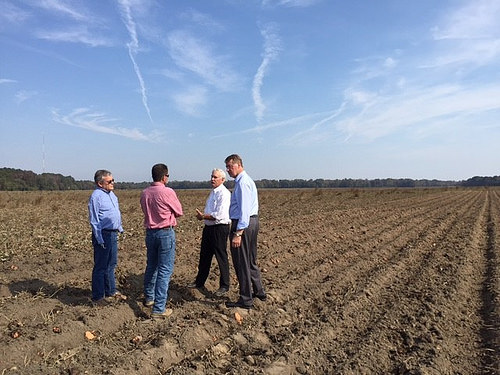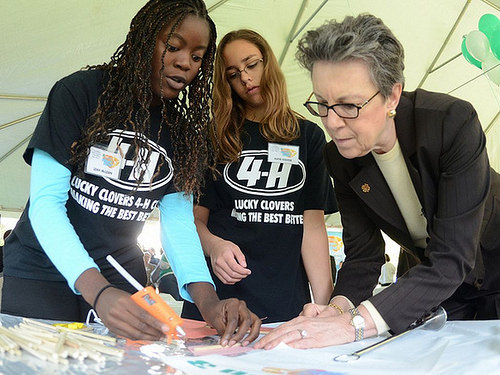
Root disease tree failure resulted in the loss of this car.
The old proverb: “You can’t see the forest for the trees” should have continued with a line saying that it’s even harder to see below the trees. Because seeing under trees, their root system to be exact, is how scientists understand and appreciate the things that will determine what we all see in our future forests. A new publication just released by the US Forest Service seeks to help forest managers recognize important root diseases and provide the best management strategies.
Ordinarily, we depend on decay organisms to break down wood to recycle enormous amounts of above ground materials such as leaves, limbs, and tree trunks. Without these subterranean decomposers, we would find ourselves buried in forest debris. But what makes beneficial decay organisms go bad and attack the root systems of living trees? In a word, disease. Read more »

Environmental trading markets are springing up across the nation.
Environmental trading markets are springing up across the nation with goals of facilitating the buying and selling of ecosystem services and helping more private landowners get conservation on the ground.
USDA Secretary Tom Vilsack and EPA Administrator Gina McCarthy joined Virginia Governor Terry McAuliffe in December 2014 to announce the state’s first trade under its nutrient trading program for stormwater. Read more »
Tags: CIG, Conservation, Conservation Innovation Grant, environmental markets, EPA, EQIP, Farm Bill, Farmers, Food Farm and Jobs Bill, innovation, Jason Weller, NRCS, Producers, rural communities, Tom Vilsack, Virginia, water, water quality
 Conservation
Conservation

With a new view from above, diverse teams of researchers help deliver information to farmers using useful, inexpensive unmanned aerial systems (UAS).
This post is part of the Science Tuesday feature series on the USDA blog. Check back each week as we showcase stories and news from USDA’s rich science and research portfolio.
Just like a smart phone helps users learn, communicate and make important decisions, smart technology—known as precision agriculture—helps farmers know and apply critical information about the right investments in fertilizer, seed, pesticide and water needed to produce their crops. Through new technologies, farmers produce more efficiently and see an increase in profits while improving stewardship of ecosystems and local communities.
To talk about precision agriculture is to talk about mapping the amount of a crop grown per acre (yield) or the types of soils in a given area. It also includes the technology that automatically guides farm machines and controls variables like the rates of seeds, fertilizers or chemicals. Read more »

Under Secretary Michael Scuse, North Carolina FSA State Executive Director Bob Etheridge, and FSA County Executive Director Kenny Johnson stand with farmer Kent Smith to assess flood damage to his sweet potato crop in Tarboro, North Carolina.
When Hurricane Matthew hit last month, disaster struck as high flood waters devastated communities up and down the East Coast. Agricultural producers in Eastern North Carolina were hit especially hard and suffered devastating losses to crops, livestock, and property.
Secretary Vilsack recently designated 39 counties in North Carolina as primary natural disaster areas, in addition to 15 contiguous counties. This week, I traveled to the state to visit some of the communities that were affected. I saw a peanut farm littered with uprooted plants and cracked shells. I met with an organic tobacco producer whose top soil had completely washed away. I visited a sweet potato and soybean farm that suffered hundreds of thousands of dollars in losses. We drove by washed out roads and gutted homes with waterlogged furniture piled high on the side of the road. Read more »
Tags: Crop Insurance, D-SNAP, disaster, disasters, Emergency Assistance for Livestock Honeybees and Farm-Raised Fish Program, forest restoration, Livestock Indemnity Program, Michael Scuse, Noninsured Crop Disaster Assistance Program, North Carolina, Producers, Tom Vilsack, Tree Assistance Program
 Environment
Environment

Dr. Woteki works with 4-H members.
The past eight years have been an extraordinary time for agricultural science, and for the application of new insights from other fields to enhance agricultural productivity and the overall agricultural economy. As the final days of this administration are approaching, it gives me a great deal of pride to look back at what USDA has accomplished in the areas of research and innovation.
Scientific research is a fundamental part of our mission at USDA. But, ultimately, what’s behind all the science is people – people who do the research and people who are affected by it. As USDA’s Chief Scientist and Under Secretary for Research, Education and Economics, I’ve met and worked with both as I’ve traveled across the country and around the world. Read more »

NRCS Soil Conservation Technician Allen Hughes mailed longleaf pine needles from his backyard to Oregon to be used to weave baskets, a Native American tradition across the U.S. Photo: Justin Fritscher, NRCS.
The 567 federally-recognized Native American Tribes are unique in their own way—from their languages and family structure, to their clothing and food. Tribes are working hard to revive their roots to help reconnect their heritage to the land, rekindle their spiritual bonds and cultural traditions, and raise awareness amongst future generations; especially tribal youth in line to inherit the land.
USDA’s Natural Resources Conservation Service (NRCS) works with the tribes like the Choctaw Indians, comprised of nearly 10,000 members across the United States, to farm and harvest hickory king corn and other heirloom white varieties, and process them to make hominy. Hominy is made from dried corn kernels, but it is expensive to purchase. NRCS provides the tribe with technical assistance to help transform idle land into a hominy-making enterprise–enabling the tribe to provide their own locally-grown, fresh produce, and cut their expenses by growing the corn. Read more »
Tags: Choctaw Indians, Conservation, Farmers, longleaf pines, Louisiana, Mississippi, Native Americans, NRCS, Oregon, Producers, Ranchers, Tribal, tribes
 Conservation
Conservation






